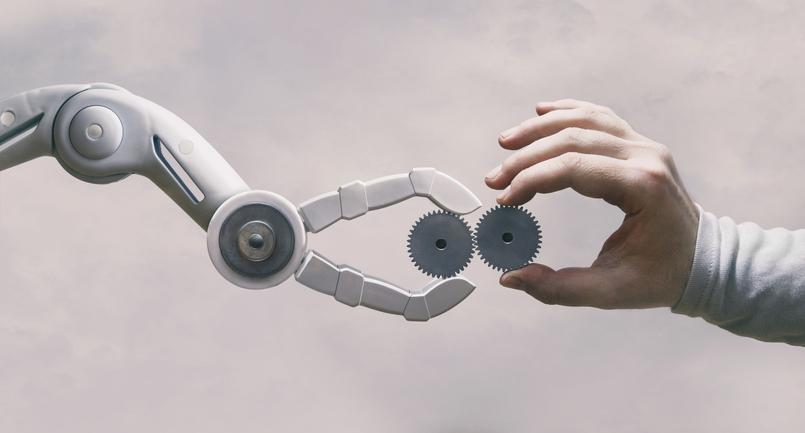Director of Smart Manufacturing
- FMA
- The Fabricator
- FABTECH
- Canadian Metalworking
Categories
- Additive Manufacturing
- Aluminum Welding
- Arc Welding
- Assembly and Joining
- Automation and Robotics
- Bending and Forming
- Consumables
- Cutting and Weld Prep
- Electric Vehicles
- En Español
- Finishing
- Hydroforming
- Laser Cutting
- Laser Welding
- Machining
- Manufacturing Software
- Materials Handling
- Metals/Materials
- Oxyfuel Cutting
- Plasma Cutting
- Power Tools
- Punching and Other Holemaking
- Roll Forming
- Safety
- Sawing
- Shearing
- Shop Management
- Testing and Measuring
- Tube and Pipe Fabrication
- Tube and Pipe Production
- Waterjet Cutting
Industry Directory
Webcasts
Podcasts
FAB 40
Advertise
Subscribe
Account Login
Search
The coming alliance of connected workers and robots
Embracing collaboration between robots and humans moves manufacturing into the future
- By Eric Whitley
- November 3, 2023
- Article
- Automation and Robotics

Robots will never fully replace human workers because they lack intuition and creativity. That's why the future of manufacturing lies in integrating them with connected workers to achieve efficiency and innovation. Ivan Bajic/E+
The metal forming and fabricating industry has reached a point of transformation. Historically reliant on manual labor and traditional techniques, it’s now in the middle of a digital revolution. Technological advancements and the push for efficiency have nudged this sector to explore novel approaches to production.
The allure of automation is undeniable, with manufacturers seeking ways to maximize production while minimizing costs. Robots have found a place in metal forming, prompting a crucial question: How do humans fit into this automated landscape?
The answer, many believe, lies in a harmonious partnership between connected workers and their robotic counterparts.
Connected Workers and Their Tools
Connected workers embody a blend of traditional craftsmanship and digital acumen. They harness modern tools while retaining the wisdom of experience, making them indispensable assets. Their unique position allows them to bridge the gap between human and machine, enhancing productivity and efficiency.
To be termed connected, workers must be equipped with a suite of advanced tools that elevate their capabilities, making them integral parts of the modern and connected manufacturing.
Wearable Devices. Gone are the days when manual health checks dominated the work environment. Today’s wearable devices, such as health wristbands, are comfortably worn on the body and automatically alert supervisors if a worker’s vital signs are indicating stress or fatigue. This proactive approach helps ensure worker well-being during demanding tasks, an advancement from relying on workers themselves to report health issues.
Augmented Reality Glasses. Shifting away from the cumbersome process of consulting paper manuals or computer screens, AR glasses are revolutionizing how workers interact with machinery. These innovative eyepieces overlay vital virtual data onto the physical world. On a bustling shop floor, workers can receive assembly instructions directly superimposed on the machine they’re working on, helping ensure accuracy and efficiency.
Real-Time Communication Systems. Hand-held radios and landline phones have become relics of the past. Voice-activated real-time communication platforms, designed for instantaneous information exchange, empower workers to relay crucial details immediately. For instance, upon spotting a product defect, a worker can alert the quality control team without any manual intervention.
Smart Gloves. Manual assembly and material handling get a touch of modernity with smart gloves, which have sensors that detect and guide movement. Imagine a worker attempting to assemble parts: these gloves, sensing an incorrect movement, vibrate to signal an error. Such immediate feedback ensures precision in tasks and reduces dependence on constant supervisor oversight.
Digital Workstations. The traditional static workbench is transforming into a digital workstation. These interactive hubs with screens or projection systems not only provide animated assembly instructions, reducing reliance on printed guidelines or worker recall, but also highlight potential hazards and demonstrate optimal tool placements.
IoT Sensors. Reactive machinery maintenance—attending to tools after they break down—is being replaced by the predictive capabilities of Internet of Things (IoT) sensors. Embedded in machinery, these devices collect data continually to anticipate wear and tear. When maintenance is imminent, connected workers receive this data directly, allowing them to schedule repairs preemptively to prevent unexpected downtime.
Advantages of Integrating Connected Workers and Robots
Operational Efficiency. With real-time communication at their fingertips, connected workers can identify and address challenges quickly. Data sharing becomes instantaneous, allowing for on-the-spot adjustments and decision-making. Such a system helps enhance problem-solving to drive production without avoidable hitches.
Downtime decreases significantly when workers get connected. Their improved ability to address malfunctions or guide robotic recalibrations helps ensure the production line rarely comes to a standstill.
Innovation. Enter cobots—robots designed to work alongside their human peers. Through their interactions, cobots absorb human expertise, refining their operations. Simultaneously, workers learn to optimize robotic functionalities, creating a symbiotic relationship in which knowledge flows both ways.
Human and robot collaboration also enables a constant feedback loop, with both parties sharing insights and experiences. Out of this dynamic exchange, novel processes and techniques often take root, pushing the boundaries of what's possible in manufacturing.
Adaptability. Market demands fluctuate, necessitating nimble responses from manufacturers. Connected workers, armed with their digital prowess, can help reprogram robots quickly to meet new production requirements. Such adaptability can be the difference between seizing an opportunity and missing it altogether.
Real-time data is the lifeblood of modern manufacturing. Connected workers use this data to identify and adapt to shifting market trends. Acting on these insights, they can pivot processes to help keep the factory’s output in sync with market demands.
The Future Shop Floor: Predictions and Implications
The typical shop floor, once dominated by stand-alone machines and bustling workers, faces an overhaul. Anticipate a landscape where robots and humans work in tandem, perhaps with dedicated zones fostering collaboration. How might manufacturing spaces evolve in the near future?
Centralized Monitoring Stations. As connected workers collaborate closely with robots, there will be a need for centralized hubs where human supervisors can oversee both robotic operations and worker data in real time. Instead of scattered workstations, centralized monitoring stations would act as nerve centers, allowing quick adjustments to robotic tasks and immediate response to worker feedback or needs.
Flexible Production Lines. The adaptability of robots, combined with real-time insights from connected workers, would allow production lines to be more fluid and adaptable to changing demands. Rather than rigid assembly lines, modular robotic stations could be reconfigured swiftly, and workers could be reallocated based on real-time data.
Enhanced Safety Zones. With robots taking on more dynamic roles and workers being more mobile with their connected tools, safety areas will need to be more clearly defined and adaptable. Interactive floor projections or barriers that light up can be used to adjust safe zones dynamically based on the task or machine operation.
Collaborative Work Pods. A fusion of human creativity and robotic precision may lead to dedicated areas where robots and humans work side by side on intricate tasks. These pods would be equipped with tools and interfaces tailored for joint operations, allowing, for instance, a robot to hold a heavy component steady while a connected worker performs a delicate welding task.
Real-Time Inventory Management. An automated system, with inputs from both robots and connected workers, could track materials and parts in real time to help optimize storage and retrieval. This system would replace traditional storerooms or inventory areas with dynamic zones where robots fetch materials as needed based on worker requests or production data.
Interactive Training Areas. Onboarding and upskilling will become essential, and dedicated zones using AR and virtual simulations will likely facilitate this. New workers or those learning new tasks could step into these zones, where they would be guided by simulations, practicing their tasks alongside virtual robots before transitioning to the live floor.
Traditional skills, while still valuable, will need to be complemented by new competencies. Workers will require training in digital literacy, robot operation, and data interpretation.
The evolution of technology often brings ethical dilemmas to the fore. Job displacement remains a genuine concern, with robots taking on roles once reserved for humans. Upskilling becomes not just a matter of economic progress but also of social responsibility, ensuring workers aren't left behind in the digital wave.
Challenges to Implementation
Marrying diverse technological systems with traditional manufacturing processes poses challenges. Disparate systems might resist integration, creating bottlenecks and inefficiencies. Manufacturers must meticulously select and design systems that can coexist harmoniously, creating a cohesive operational framework.
Resistance to change is a human trait. Traditional workers, accustomed to time-tested methods, might view the digital shift with skepticism. Educating them about the tangible benefits of human-robot synergy is an essential step, ushering in a cultural shift towards embracing this technology.
Investing in advanced technologies and worker training demands significant capital, and the financial constraints can't be overlooked. However, manufacturers must weigh these costs against potential long-term gains, recognizing that such investments could hold the key to future profitability and industry leadership.
Allies for Innovation
The narrative here isn't one of robotic takeover but of partnership. Robots, for all their capabilities, can't replicate human intuition, creativity, or experience. Recognizing this, the industry's future seems destined to be one where humans and robots collaborate, creating a symphony of efficiency and innovation.
The alliance between connected workers and robots presents a golden opportunity. Being forward-thinking and embracing this synergy positions manufacturers to enhance their operations while charting a progressive course for the entire industry.
About the Author

Eric Whitley
299 S. Main St. Suite 1300
Salt Lake City, UT 84111
(877)-225-5201
subscribe now

The Fabricator is North America's leading magazine for the metal forming and fabricating industry. The magazine delivers the news, technical articles, and case histories that enable fabricators to do their jobs more efficiently. The Fabricator has served the industry since 1970.
start your free subscription- Stay connected from anywhere

Easily access valuable industry resources now with full access to the digital edition of The Fabricator.

Easily access valuable industry resources now with full access to the digital edition of The Welder.

Easily access valuable industry resources now with full access to the digital edition of The Tube and Pipe Journal.
- Podcasting
- Podcast:
- The Fabricator Podcast
- Published:
- 04/16/2024
- Running Time:
- 63:29
In this episode of The Fabricator Podcast, Caleb Chamberlain, co-founder and CEO of OSH Cut, discusses his company’s...
- Trending Articles
Tips for creating sheet metal tubes with perforations

Are two heads better than one in fiber laser cutting?

Supporting the metal fabricating industry through FMA

JM Steel triples capacity for solar energy projects at Pennsylvania facility

Omco Solar opens second Alabama manufacturing facility

- Industry Events
16th Annual Safety Conference
- April 30 - May 1, 2024
- Elgin,
Pipe and Tube Conference
- May 21 - 22, 2024
- Omaha, NE
World-Class Roll Forming Workshop
- June 5 - 6, 2024
- Louisville, KY
Advanced Laser Application Workshop
- June 25 - 27, 2024
- Novi, MI


























